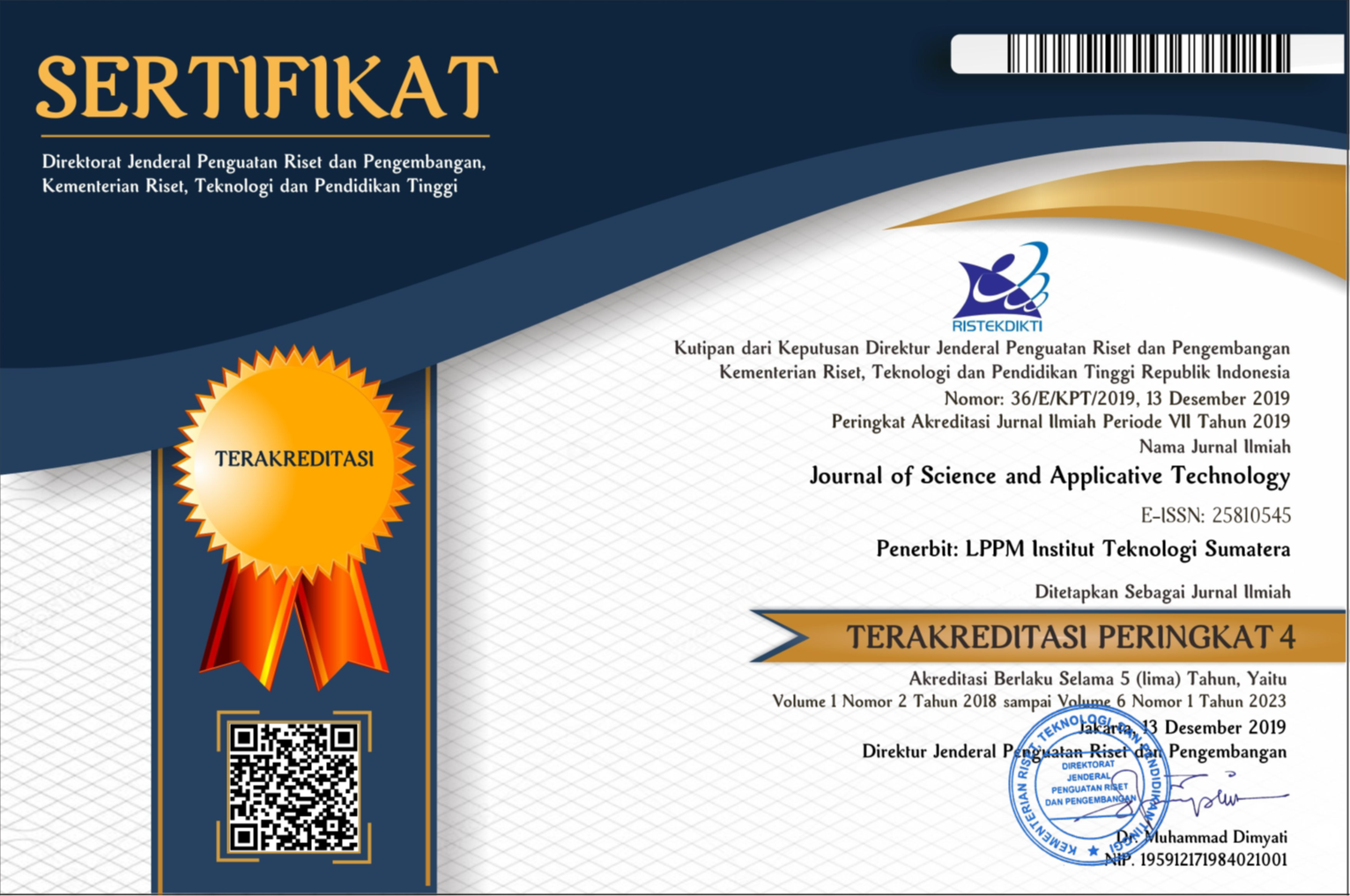Green Synthesis ZnO Nanoparticles Using Rinds Extract of Sapindus rarak DC
Abstract
The green synthesis of ZnO nanoparticles was carried out using a natural capping agent, Sapindus rarak DC rinds extract at low-temperature calcination and environmentally friendly solvent. The mixture of Zn(CH3COO)2, NaOH, and rinds extract was sonicated for 4 h at room temperature. The calcination was carried out at low temperature, 95oC for 8 h, and resulted in pale brown powder. XRD and SEM were used to confirm the structure and to analyze the morphology of ZnO nanoparticles respectively. XRD pattern of ZnO nanoparticles was corresponding to JDCPS card no 36-1451 with hexagonal structure. The average crystal size of ZnO nanoparticles was calculated using the scherrer equation and the average size was about 35.8 nm. From this study, the extract of the rind of Sapindus rarak DC was found to be a natural capping agent to synthesis ZnO nanoparticles because Sapindus rarak DC contain a pythochemical compound to limit the interaction between crystal seeds.
Downloads
References
[2] H. F. Lin, S.C. Liao, and S. W. Hung, “The dc thermal plasma synthesis of ZnO nanoparticles for visible-light photocatalyst†Journal of Photochemistry and Photobiology A: Chemistry, vol. 174, pp. 82-87, August 2005.
[3] O. R. Vasile, I. Serdaru, E. Andronescu, R. Trusca, V. A. Surdu, O. Oprea, A. Ilie, and B. S. Vasile, “Influence of the size and the morphology of ZnO nanoparticles on cell viability†Comptes Rendus Chimie, vol. 18, pp. 1335-1343, 2015.
[4] N. Talebian, S. M. Amininezhad, and M. Doudi, “Controllable synthesis of ZnO nanoparticles and their morphology dependent antibacterial and optical properties†Journal of Photochemistry and Photobiology B: Biology, vo. 120, pp. 66-73, March 2013.
[5] L. He, Y. Liu, A. Mustapha, and M. Lin, “Antifungal activity of zinc oxide nanoparticles against Botrytis cinerea and Penicillium expansum†Microbiological Research, vol. 166, pp. 207-215, March 2011.
[6] A. Askarinejad, M. A. Alavi, and A. Morsali, “Sonochemically assisted synthesis of ZnO nanoparticles: A Novel Direct Method†Iran Journal of Chemistry and Chemical Engineering, vol. 30, pp. 75-80, September 2011.
[7] E. Maryanti, D. Damayanti, I. Gustian, S. Prima S., “Synthesis of ZnO nanoparticles by hydrothermal method in aqueous rinds extract of Sapindus rarak DC†Materials Letters, vol. 118, pp. 96-98, December 2013.
[8] T. Ghoshal, S. Biswas, M. Paul, and S. K. De, “Synthesis of ZnO nanoparticles by solvothermal method and their ammonia sensing properties†Journal of Nanoscience and Nanotechnology, vol. 9, pp. 5973-5980, 2009.
[9] A. K. Zak, W.H. A. Majid, H. Z. Wang, R. Yousefi, A. M. Golsheikh, and Z. F. Ren, “Sonochemical synthesis of hierarchical ZnO nanoparticles†Ultrasonic Chemistry, vo. 20, pp. 395-400, January 2013.
[10] T. K. Kundu, N. Karak, P. Barik, and S. Saha, “Optical properties of ZnO nanoparticles prepared by chemical method using poly(vinilalcohol) (PVA) as capping agent, International Journal of Soft Computing anf Engineering, vol. 1, pp. 19-24, July 2011.
[11] N. Matinise, X. G. Fuku, K. Karviyarasu, N. Mayedwa, and M. Maaza, ZnO nanoparticles via Moringa Oleifera green synthesis: Physical properties and mechanism of formation, Applied Surface Science, vol. 406, pp. 339-347, January 2017.
[12] Y. Silviani, “Short communication: inhibitory effect of Sapindus rarak ethyl acetate extract on Staphylococcus aureus†Bioteknganiologi, vol. 14, pp. 16-18, May 2017.
[13] J. Santhoshkumar, S. V. Kumar, and S. Rajeshkumar, : Synthesis of Zinc oxide nanoparticles using plant leaf extract against urinary tract infection pathogen†Resource-Efficient Technologies, vol. 3, pp. 459-465, May 2017.
[14] A. Nafiunisa, N. Aryanti, and D. H Wardhani, “Kinetic Study of Saponin Extraction from Sapindus rarak DC by Ultrasound-Assisted Extraction Methods†Bulletin of Chemical Reaction Engineering and Catalysis, vol. 14, pp. 468-477, May 2019.
[15] A. Rahdar, “Study of Different Capping agent effect on the structural and optical properties of Mn Doped ZnS nanostructures†World Application Programming, vol. 3, pp. 56-60, 2013.
[16] M. Phrybyzewska and M. Zaborki, “The effect of Zinc Oxide nanoparticles morphology on activity in crosslingking of carboxilated nitrile Elastromer†Express Polymer Letters, vol 3, pp. 542-552, 2009.
Copyright (c) 2021 Journal of Science and Applicative Technology

This work is licensed under a Creative Commons Attribution-NonCommercial 4.0 International License.
All the content on Journal of Science and Applicative Technology (JSAT) may be used under the terms of the Creative Commons Attribution-NonCommercial 4.0 International License.
You are free to:
- Share - copy and redistribute the material in any medium or format
- Adapt - remix, transform, and build upon the material
Under the following terms:
- Attribution - You must give appropriate credit, provide a link to the license, and indicate if changes were made. You may do so in any reasonable manner, but not in any way that suggests the licensor endorses you or your use.
- NonCommercial - You may not use the material for commercial purposes.
- No additional restrictions - You may not apply legal terms or technological measures that legally restrict others from doing anything the license permits.





















